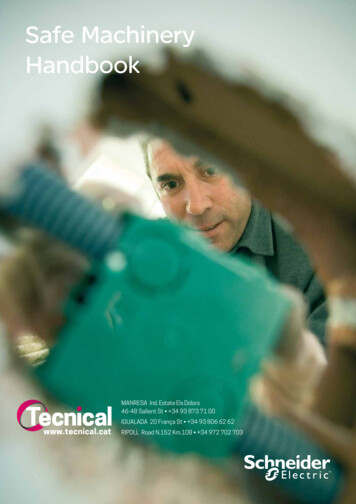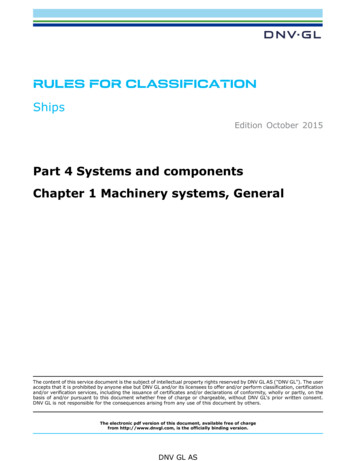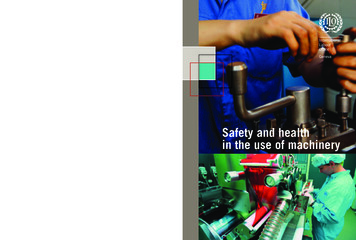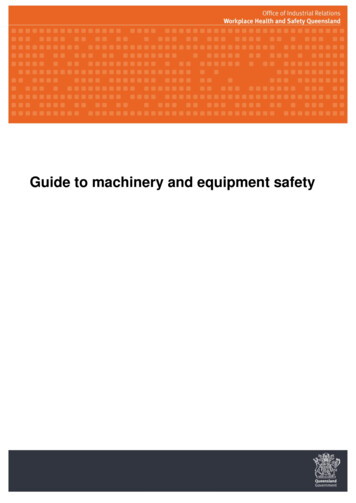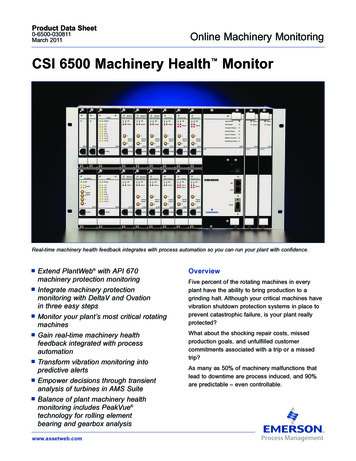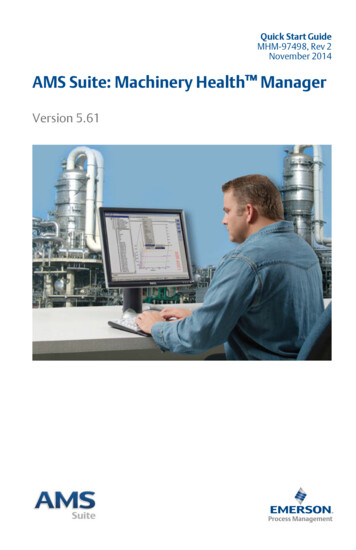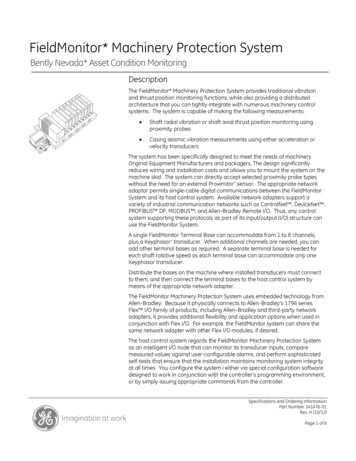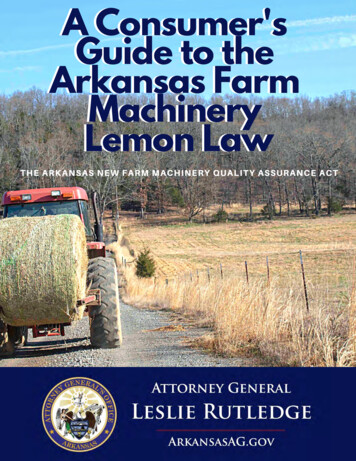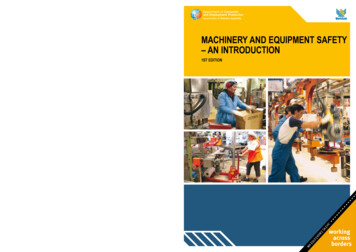
Transcription
WorkSafemachinery and equipment safety– an introduction1ST EDITIONWorkSafeInfoline 1300 307 877(for the cost of a local call statewide)Westcentre 1260 Hay Street West Perth Western Australia 6005PO Box 294 West Perth Western Australia 6872Administration: (08) 9327 8777Facsimile: (08) 9321 8973National Relay Service: 13 36 .wa.gov.auRegional officesGoldfields/EsperanceGreat SouthernKimberleyMid-WestNorth-WestSouth-West(08) 9021 5966(08) 9842 8366(08) 9169 2811(08) 9964 5644(08) 9185 0900(08) 9722 2888DP1979/2007/1- January 2008 - 2000This publication is available in other formats to assist people with special needs.
CONTENTSIntroduction . . . . . . . . . . . . . . . . . . . . . . . . . . . . . . . . . . . . 11. Key principles of machinery andequipment safety . . . . . . . . . . . . . . . . . . . . . . . . . . . . . 21.1 Mechanical hazards. . . . . . . . . . . . . . . . . . . . . . . 31.2 Non-mechanical hazards. . . . . . . . . . . . . . . . . . . 41.3 Access hazards . . . . . . . . . . . . . . . . . . . . . . . . . . 52. Risk control of machinery andequipment hazards. . . . . . . . . . . . . . . . . . . . . . . . . . . . 72.1 Risk control of machinery and equipmenthazards (general) . . . . . . . . . . . . . . . . . . . . . . . . 82.2 Risk control of mechanical hazards. . . . . . . . . . . 92.3 Risk control of non-mechanical hazards. . . . . . 132.4 Risk control of access hazards. . . . . . . . . . . . . 143. Purchasing machinery and equipment list. . . . . . . . 184. Information and guidance: Where to getmore information and assistance. . . . . . . . . . . . . . . 20AcknowledgementWorkSafe Western Australia acknowledges WorkSafe Victoria for the original development of this publication.DisclaimerInformation in this publication is provided to assist people in meeting their occupational safety and health obligations. While information iscorrect at the time of printing, readers should check and verify any legislation referenced in this publication to ensure it is correct at the timeof use.Changes in law after this document is published may impact upon the accuracy of information. This information is provided as a service tothe community. It is made available in good faith and is derived from sources believed to be reliable and accurate at the time of publication.
IntroductionMachinery and Equipment Safety: An Introduction is provided in accordance withthe Occupational Safety and Health Act 1984 (OHS Act) to assist employers andemployees comply with their duties and obligations.This guide is an introduction to managing the risks associated with use ofmachinery and equipment in the workplace.Employers can use this guide to: identify machinery and equipment hazards in the workplace eliminate or reduce the risk of those hazards causing harm.The guide will also be useful to anyone else who is interested in machinery andequipment safety, such as employees and Safety and Health Representatives.WorkSafe also has additional guidance supporting all topics introduced in thisdocument. To find out more or to seek further technical information with regardto your machinery and equipment, refer to Section 4 of this document.Consulting employees and Safety AND HEALTHRepresentativesConsultative processes allow people to provide input and raise potential safetyconcerns about the work they undertake. Although hazards associated withmachinery and equipment are often easily identified, the ways in whichpeople can gain access to, or may be exposed to, hazards require a detailedunderstanding of how they do their job.MACHINERY AND EQUIPMENT SAFETY – AN INTRODUCTION 1
1Key principles ofmachinery andequipment safetyRisks associated with:1.1 Mechanical hazardst hat cannot be eliminated must becontrolled to prevent harm.1.2 Non-mechanical hazardst hat cannot be eliminated must becontrolled to prevent harmful exposure.1.3 Access hazards2t hat cannot be eliminated must becontrolled to provide safe access(for operation, maintenance, repair,installation, service, cleaning ordecommissioning).MACHINERY AND EQUIPMENT SAFETY – AN INTRODUCTION
Key principles of machineryand equipment safety1.1 Mechanical hazardsMachines have moving parts. The action of moving parts may have sufficient forcein motion to cause injury to people.When reviewing machinery and equipment for possible mechanical hazards,consider: machinery and equipment with moving parts that can be reached by people machinery and equipment that can eject objects (parts, components, productsor waste items) that may strike a person with sufficient force to cause harm machinery and equipment with moving parts that can reach people such asbooms or mechanical appendages (arms) mobile machinery and equipment, such as forklifts, pallet jacks, earth movingequipment, operated in areas where people may gain access.Robotic arms can reach over their base, movewith remarkable speed and high force, andcan cause injury if controls to separate peoplefrom moving plant are not implemented.Common mechanical hazards and associated risks for machinery and equipmentare shown below.Mobile plant operated in areas where peoplework may cause injury through collision. Trafficcontrol and segregation are forms of control.hazardRiskRotating shafts, pullies, sprockets and gearsEntanglementHard surfaces moving togetherCrushingScissor or shear actionSeveringSharp edge – moving or stationaryCutting or puncturingCable or hose connectionsSlips, trips and falls (e.g. oil leaks)Further InformationCommission for Occupational Safety and Health guidance notes: Plant in the workplace Powered mobile plant Safe movement of vehicles at workplaces Working safely with forkliftsMACHINERY AND EQUIPMENT SAFETY – AN INTRODUCTION 3
Key principles of machineryand equipment safety1.2 Non-mechanical hazardsNon-mechanical hazards associated with machinery and equipment can includeharmful emissions, contained fluids or gas under pressure, chemicals and chemicalby-products, electricity and noise, all of which can cause serious injury if notadequately controlled. In some cases, people exposed to these hazards maynot show signs of injury or illness for years. Where people are at risk of injurydue to harmful emissions from machinery and equipment, the emissions should becontrolled at their source.When reviewing machinery and equipment for possible non-mechanicalhazards, consider how machines and equipment can affect the area(environment) around them.Common non-mechanical hazards are shown below.Woodworking dust generated by a buzzer isremoved via forced extraction and ventilation.Non-mechanical hazardsDustMist (vapours or fumes)Explosive or flammable atmospheresNoiseHeat (radiated or conducted)Ignition sources (flame or spark)High intensity light (laser, ultra-violet)Molten materialsHeavy metals (lead, cadmium, mercury)ChemicalsSteamPressurised fluids and gasesIonising radiation (x-rays, microwaves)ElectricalWelding fumes are extracted via flexible,locatable forced extraction and ventilation system.Further InformationCommission for Occupational Safety and Health codes of practice: Managing noise at workplaces Spray paintingCommission for Occupational Safety and Health guidance notes: Controlling wood dust hazards Controlling Isocyanate hazards at work Prevention of carbon monoxide poisoning from petrol and gas poweredequipment Material safety data sheets4MACHINERY AND EQUIPMENT SAFETY – AN INTRODUCTION
Key principles of machineryand equipment safety1.3 Access hazardsPeople must be provided with safe access that is suitable for the work they performin, on and around machinery and equipment. A stable work platform suited to thenature of the work that allows for good posture relative to the work performed, surefooting, safe environment and fall prevention (if a fall may occur) is a basicrequirement.As an example, cooling towers on building roofs may have poor access, yet mustbe attended by a service person at predictable times for water treatment, chemicaldosing or monitoring of automated dosing equipment. People performing thesetasks must be provided with the means to get themselves and any equipment theyrequire onto the roof with no risk or minimal risk of fall or injury.When thinking about safe access to machinery and equipment, think about how,who, when and what: who will be working on or around the machinery and equipment? people required to work in enclosed areas where the atmosphere couldbe harmful, such as pits, tanks or storage vessels? what equipment or materials need to be carried to undertake the task? where and when is access required for operation, maintenance and cleaning? how will people gain safe access (walkway, gantry, elevated work platformor ladder)? what work will be carried out during access? will people be near or exposed to an unidentified mechanical ornon-mechanical hazard at the time of access? has consultation occurred with employees or contractors regarding how theyintend to gain access, and what equipment and work platform or structure isbest suited for the intended task?Permanently fixed gantries, ladders andwalkways are incorporated into this machineryand equipment to reduce the risk of a fall fromheight occurring during operationand maintenance.AccessAccess needs can be predicted and access planning must occur in advance.People need access to machinery and equipment in the workplace (either continuallyor occasionally) for tasks such as operation, maintenance, repair, installation,service or cleaning. These tasks are examples of access that can be predicted.Access may vary during each stage of machinery and equipment life cycle.For example: installation or removal– complete access from every area may be required, and involvedisconnection or connection of services such water, air, pipes,installation of electrical cable to switch board, etc. operation– access for set-up, operation and adjustment. maintenance, repair, cleaning, alteration or adaptation– access to remote areas may be required.Further InformationCommission for Occupational Safety and Health code of practice: Prevention of falls at workplacesCommission for Occupational Safety and Health guidance note: Working aloneMACHINERY AND EQUIPMENT SAFETY – AN INTRODUCTION 5
Key principles of machineryand equipment safetyExamples of common hazards by type of workplace activityPeople who install or dismantle machines and equipment could: work in isolation work on machines and equipment at height or over machinery or equipment to connect services (such as electricity, air or water) work in low light or with bright directional light access machinery and equipment from the top, sides or underneath work with/near cranes, forklift or rigging to lift machinery and equipment work in confined spaces use power tools, welders, extension leads, which present electrical hazards if damaged or wet.People operating machines and equipment could: b e required to place their hands close to the mechanism of the machinery or equipment that does the work, and may be injuredif caught or trapped by moving parts b e exposed to constant harmful noise, radiated energy or fumes being emitted from the machinery and equipment they are operatingor are close to inadvertently bump or knock poorly placed control levers or buttons be required to make adjustments to the mechanism of machinery and equipment while the machine is in motion be required to clear away scrap make minor adjustments or reach into the moving mechanism of the machine they are operating.People providing maintenance or repair services could: work alone work on machines and equipment at height, or over machines and equipment to connect services (such as electricity, air or water) access machines and equipment from the rear or sides need to enter confined spaces of larger machinery and equipment b e trapped by mechanism of the machinery and equipment through poor isolation of energy sources or stored energy, such asspring-loaded or counter-balance mechanisms, compressed air or fluids, or parts held in position by hydraulics or pneumatic (air) rams m ove heavy parts when changing the set-up of machinery and equipment, or repairing failed parts such as electric motorsor gear box assemblies disable or remove normal safety systems to access machines and equipment mechanism.People providing cleaning services could: work alone access machines and equipment from the rear or sides or in unexpected ways climb on machines and equipment enter confined spaces of larger machines and equipment b ecome trapped by mechanism of the machinery and equipment through poor isolation of energy sources or stored energy, such asspring-loaded or counter-balance mechanisms, compressed air or fluids, or parts held in position by hydraulics or pneumatic (air) rams work with chemicals operate electrical equipment in wet areas.6MACHINERY AND EQUIPMENT SAFETY – AN INTRODUCTION
2Risk control ofmachinery andequipment hazards2.1 R isk control of machinery andequipment hazards (general)2.2 Risk control of mechanical hazards2.3 Risk control of non-mechanical hazards2.4 Risk control of access hazardsMACHINERY AND EQUIPMENT SAFETY – AN INTRODUCTION 7
Risk control of machineryand equipment hazards2.1 Risk control of machinery and equipmenthazards (general)Where exposure to machinery and equipment hazards cannot be eliminated orsubstituted for machinery and equipment of improved design, risk control(s) mustbe applied to the hazards that prevents or reduces the risk (chance) of injury orharm. Health and safety laws require the highest order control be applied so faras is reasonably practicable.Centre lathe: The exposed rotating chuckof a centre lathe can eject parts or tools withgreat force, cutting fluid fumes are difficultto contain and the machinery requiresmanual set-up.Higher order machinery and equipment risk controls are preventative by nature,are effective and durable for the environment it is used in, and deal directly withthe hazard at its source.Lower order machinery and equipment risk controls, such as personal protectiveequipment (PPE), can prevent injuries, but are generally not as effective as higherorder controls, as they rely more on employee behaviour, maintenance programsand supervision.Administrative controls use systems of work to reduce risk by providing aframework of expected behaviours. Examples are rotation of staff to reduceexposure to a hazard, or a documented safe system of work, such as ‘lockout-tag out’. These types of controls rely on extensive instruction, information,training and supervision. In terms of time and ongoing administration by managersand employers to ensure the desired behaviour occurs, administrative controls canbe the most expensive and least effective form of hazard control.CNC Lathe: Substituting a centre lathe witha CNC lathe (Computer Numeric Control) is anexample of improved risk control of machineryand equipment through improvement in design.8Note: The use of PPE and administrative controls are low or last order controlsused to deal with any residual risk associated with the hazard.As such, these last resort controls can be used in support of higher order controlsthat deal with a hazard at its source and should not be consideredas the sole means of control. These types of risk controls require constantmonitoring and reinforcement.Effective machinery and equipment risk controls reflect some or all of thefollowing characteristics: the hazard is controlled at its source contact or access to the hazard is prevented sturdy construction (correct materials with few points of potential failure) fail-safe (failure of the control system to be effective will result in machineryshut-down) tamper-proof design (as difficult as possible to bypass) presents minimum impediment to machinery and equipment operator easy to inspect and maintain does not introduce further hazards through action of the risk control.MACHINERY AND EQUIPMENT SAFETY – AN INTRODUCTION
Risk control of machineryand equipment hazards2.2 Risk control of mechanical hazardsSeparation is a simple and effective machinery and equipment risk control.Separation may be achieved by distance, barrier or time. Distance separation means a person cannot reach the hazard due to distance. Barrier separation means an effective barrier or guard denies access andcontrols ejection of parts, products or waste. Time separation means at the time of access, the machinery or equipmentis disabled.Fences, barriers, guards and interlocked gatesseparate people from the hazardous actionof machinery and equipment.Examples include: physical barriers and guards such as fences, screens or fixed panels ofvarious materials various forms of guarding and interlocking (as described in Australian StandardAS 4024, part 1601 and part 1602, Safety of Machinery) making the hazard inaccessible by reach (where the distance between a personand the hazard forms an effective barrier).Note: When considering the suitability of distance guarding, also consider the safeaccess requirements of maintenance people who gain access by ladder, scaffold orelevated work platform.GuardingA guard can perform several functions: it can deny bodily access, contain ejectedparts, tools, off-cuts or swath, prevent emissions escaping or form part of a safeworking platform.An old style power press incorporating amanual interlock and adjustable guarding.If the guard slides up, a connected metalbar separates the clutch mechanism andthe press will not activate.The guard can be adjusted to provide anopening by releasing retaining bolts on theguard face to allow individual panels to move.Adjustment must be performed by anexperienced person to ensure the resultingopening only provides room necessary toincorporate the material being fed in andprevents hands or fingers intruding into thedanger area.Guarding is commonly used with machinery and equipment to prevent access to: rotating end drums of belt conveyors moving augers of auger conveyors rotating shafts moving parts that do not require regular adjustment machine transmissions, such as pulley and belt drives,chain drives, exposed drive gears any dangerous moving parts, machines or equipment.Where access is not anticipated, a fixed guard can be permanently applied bybonding agent, welding or secured with one-way screws. If access is generallynot required, a permanently fixed barrier is the preferred option.Where access to the hazard is infrequent, the installation of a fitted guard thatcan be removed by use of a tool may be an acceptable control, where the toolto remove the barrier or guard is not normally available to the operator.Adjustable guarding incorporates movable sections or panels of the guard andallows for material or parts to be fed into the guarded area while still preventingbodily contact.MACHINERY AND EQUIPMENT SAFETY – AN INTRODUCTION 9
Risk control of machineryand equipment hazardsTunnel guards provide a tunnel, aperture or chute in which material can beinserted into the machinery and equipment, but due to the restrictive designand depth of the opening, fingers, hands, arms or the entire person is preventedfrom intruding into the danger area.Where frequent cleaning is required, the guard may be constructed of mesh thatprevents intrusion of body parts but allows for hosing. Food production workplacesthat use conveyors in areas where hygiene or food safety is an integral part of theoperation use fixed mesh guarding of conveyor end rollers.Interlock guarding occurs when the act of moving the guard (opening, slidingor removing) to allow access stops the action of the hazardous mechanism.The narrow throat of the mincer prevents aperson’s hand from accessing the hazard.Interlock guarding works by: mechanically disconnecting the drive mechanism (applies a brake or disengagesa clutch or geared mechanism) isolating the power source of the drive mechanism (stops the motor) a combination of mechanical and power disconnection.Interlock guarding is generally achieved via mechanical or electrical means, butmay also include hydraulic or pneumatic control systems.The energy stored in moving parts (momentum) can cause the mechanism of themachine or equipment to run on for some time after the source of driving energyhas been removed.For access panels or doors supporting an interlocking device that allows accessto mechanical parts that move for periods after the energy source is removed,a separate mechanism to delay release of the retaining or locking mechanismmay be incorporated.An old style press refurbished with an interlockedsafety cage and gate.The control mechanism uses a combination ofpneumatics and electrical interlocking to ensurethe danger area of the press cannot be accessedunless the press downstroke action is disabled.Improved design and technology can be fitted toolder machinery and equipment to meet currentstandards and reflect the latest knowledgeregarding ways to control hazards and risksin the workplace.Captive key systems rely upon a single key that is shared between thecontrol panel (‘on’ switch) and the access gate lock of the physical barrierto the danger area. Removal of the key from the control panel can only occur whenthe switch is in the off position, and the gate will only release the keywhen in the locked position.Captive key systems do not provide full isolation of the power source, but mayprovide limited temporary access under controlled conditions.Effective supervision, instruction and training are required as administrativecontrols to ensure that only one key is available for the system, and the keyis not removed from the access gate or guard by a second operator whilea person is exposed to the danger area of the plant. Operations such asmaintenance, repair, installation service or cleaning may require all energysources to be isolated and locked out to avoid accidental start-up.Captive key systems: The key cannot beremoved unless it is in the off position. Thesame key is used to unlock the access gate.Only one key per system is retained by thelocking mechanism.10MACHINERY AND EQUIPMENT SAFETY – AN INTRODUCTION
Risk control of machineryand equipment hazardsOther mechanical hazard risk control optionsSimultaneous two-handed operationWhere a machine has only one operator, the use of simultaneous two-handedoperation buttons can serve as a risk control. This ensures that operation of thehazardous mechanism cannot occur until both hands are clear of the danger area.The two buttons must be pushed at the same time and are located at a distancefrom each other that prevents simultaneous operation by one hand.A two-handed control option may be suitableto ensure that a machine cannot operate untilboth hands of the operator are clear of thehazard area.The operation should be designed so that if either or both of the buttons arereleased, the hazardous action of the machine or equipment cannot be reached,or if it can be reached, the mechanism returns to a safe state.Presence sensing systemsIf physical guards are not reasonably practicable, then a presence sensing systemcan be used as a control to reduce risk. Presence sensing systems can be usedwhere people enter areas shared by moving production equipment.Presence sensing systems are capable of providing a high degree of flexibilitywith regard to access.Presence sensing systems detect when a person is in the identified danger area,and stops or reduces the power or speed of the mechanism at the time of entryto provide for safe access.Presence sensing systems can rely on foot pressure pads, infra-red sensing, lightbeams or laser scanning. The most appropriate type of sensing device will dependon the operating environment and access requirements.A light curtain used to disable the hazardousmechanism of a machine must resist failureand fault.Australian Standard AS 4024.2 provides guidance on design specification, ratingson integrity and reaction times. Manufacturers’ specifications for installation andmaintenance must also be observed.Specialist assistance may be required by experienced professionals to ensurecorrect selection and installation of presence sensing systems. Companieswho manufacture or supply these systems also provide technical supportand installation assistance.MACHINERY AND EQUIPMENT SAFETY – AN INTRODUCTION 11
Risk control of machineryand equipment hazardsCritical safety systemsA safety control system responsible for ensuring the safety of a person whenapproaching or accessing a hazard is called a critical safety system.Failure of the critical safety system will leave a person exposed to the hazard,and in danger.Critical safety systems may include barriers or guards fitted to prevent access, orintegrated complex interlocking and presence sensing systems. Failure to replaceguards, damaged perimeter fences that allow access and bypassed or disabledinterlocking systems are examples of critical safety systems failures that requireimmediate attention to ensure the safety of people.High integrity/fail-safe controlComponents relied on to protect peoplefrom harm are designed and built to a highstandard, and display compliance ratingsrelative to their reliability. They must also becorrectly installed to ensure their effectiveoperation.All safety control systems should be designed and built to prevent failure or, inthe event of failure, de-activate the operation of the machinery and equipment.The extent to which a safety control system should tolerate faults is a functionof risk (likelihood and consequence), and is described fully in Australian StandardAS 4024.1501 Safety Related Parts of Control Systems, which explains thecategories of control required as a function of increasing risk.Many different types of machinery and equipment use high integrity safety systemsthat disable a mechanism at the time of access. Some examples include: brake press power press robotic machine (automated machines) injection moulders powered guillotines programmable lathe and milling equipment industrial mixers mincing equipment plasma cutting tables laser cutting tables.Redundant and self-monitoring fault detection systemsRedundant or dual systems (doubling up) and self-monitoring fault detectionsystems are also effective methods to prevent failure of critical safety systems.Selection and installation of these types of complex interactive control measuresmay require expert or specialist assistance.The Australian Standards provide information on plant safety systems and reflectcurrent state of knowledge and best practice. The AS 4024 Safety of Machineryseries of publications provides specific information for commonly used machinetypes in industry such as woodworking or metal working machinery.12MACHINERY AND EQUIPMENT SAFETY – AN INTRODUCTION
Risk control of machineryand equipment hazards2.3 Risk control of non-mechanical hazardsThe first step in selecting suitable and effective controls for non-mechanicalhazards is to understand the nature of emissions that can be released bymachinery and equipment in the workplace, where those emissions collectand the way they may cause harm. Separating people from non-mechanical hazards is necessary where theemission cannot be controlled at the source through elimination or substitution.Hazardous machinery and equipment emission controls rely largely on isolationof people from the hazardous emission.Hoods, lids, covers or impervious guards (solid barriers that prevent escapeof the emission) can serve to contain a number of different types of emissionswithin machinery or equipment.For potentially harmful substance exposures from machinery and equipment,such as mist, fumes, vapour or dust, and where it is not reasonably practicableto control the emission at its source, ventilation and extraction systems are usedto remove the hazardous atmosphere from the work environment. For noise, guarding may also serve to mute noise emissions through applicationof sound absorbing materials. Other emissions such as lasers, ultra-violet light,bright light or welding flash can also be safely screened to prevent potentialharmful exposure. Oil leaks from machinery or equipment may present a serious slip hazard.By preventing oil leaks through routine maintenance, or containing leakingoil with a drip tray or through spill containment strategies, the risk the hazardpresents is controlled.Personal protective equipmentWhere it is not reasonably practicable for emissions to be controlled at their sourceor removed or reduced through effective ventilation, extraction or diversion, the useof personal protective equipment (PPE) as a final measure must be considered toensure safety.PPE is a lower order control and can only be used where higher order controlsare not reasonably practicable or are not totally effective.Selection and use of PPE requires careful consideration, as there are manydifferent types that reduce the risk of injury of contact or exposure to a hazard.Incorrect use of PPE or purchasing inappropriate PPE can contribute to seriousworkplace incidents.PPE that is uncomfortable, restrictive or heavy may create secondary hazards,and, as a result, constant supervision may be necessary to ensure it is usedeffectively.Ear muffs.Gloves.Welding mask.Safety glasses.MACHINERY AND EQUIPMENT SAFETY – AN INTRODUCTION Particle half face respirator.13
Risk control of machineryand equipment hazards2.4 Risk control of access hazardsConfined spaceLarger machinery and equipment may contain internal areas where a hazardousatmosphere may occur by design or as a result of the work being done.A confined space may exist where people re
machinery and equipment with moving parts that can reach people such as booms or mechanical appendages (arms) mobile machinery and equipment, such as forklifts, pallet jacks, earth moving equipment, operated in areas where people may gain access. Common mechanical hazards and associated risks for machinery and equipment are shown below.
